Are Electric Stoves Suitable for All Cookware?
Updated: 28 Aug 2024
412
Electric stoves have become increasingly popular for their sleek design and consistent heating. However, many home cooks question whether their existing cookware is compatible with these modern stoves. This is a crucial consideration, as not all pots and pans work well on electric surfaces.
Choosing the right cookware for your electric stove is essential for optimal cooking performance and safety. Understanding cookware compatibility ensures your meals are cooked evenly and your stove remains in good condition.
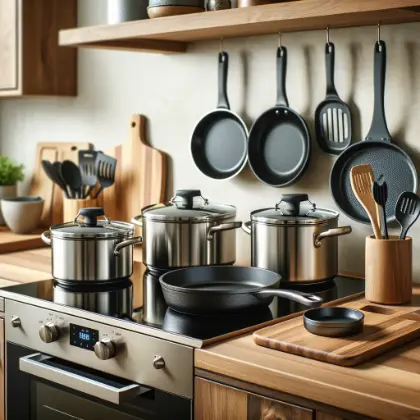
This post will explore the types of electric stoves and the best cookware options for each and learn about the benefits and limitations of different cookware materials. Let’s dive in and discover the best cookware choices for your electric stove.
Understanding Electric Stoves
Electric stoves are a common choice in many kitchens. Let’s explore the different types of electric stoves and their benefits.
Types of Electric Stoves
Coil Electric Stoves
Coil electric stoves have visible, round heating elements on the cooktop. The coils are usually removable, making them easy to clean and replace if needed.
Benefits:
- Coil burners are tough and can withstand heavy use.
- These stoves are generally less expensive than other types of electric stoves.
- They heat up relatively quickly, making them good for fast cooking.
Smooth-Top Electric Stoves
Smooth-top electric stoves have a flat, glass-ceramic surface with heating elements underneath. These elements heat the glass top, which then transfers heat to the cookware.
Benefits:
- The smooth surface is easy to wipe down after cooking.
- They look stylish and can give your kitchen a modern feel.
- The flat surface allows for more even heating compared to coil stoves.
Induction Stoves
Induction stoves use electromagnetic energy to heat pots and pans directly. The cooktop itself stays cool because it does not generate heat; instead, it induces heat within the cookware.
Advantages:
- Induction stoves are more energy-efficient because they heat the cookware directly without wasting heat.
- The cooktop stays cool, reducing the risk of burns.
- They offer very precise temperature control, making them ideal for delicate cooking tasks.
Are Electric Stoves Suitable For All Types of Cookware?
Electric stoves are versatile and convenient, but not all cookware is equally suitable for them. The best options are flat-bottomed pans made from heavy-gauge metals like stainless steel, aluminum, and copper.
These materials ensure efficient heat conduction and even cooking. Cast iron can also be a good choice, but it is essential to have a smooth bottom to avoid scratching the stovetop.
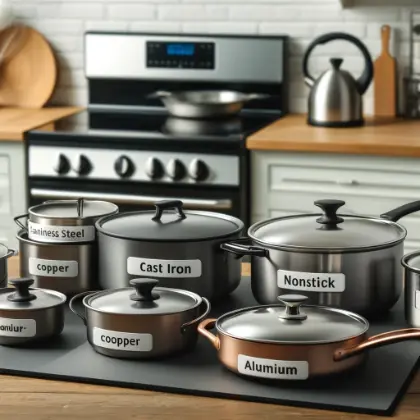
On the other hand, certain types of cookware may not perform as well on electric stoves. Warped pans can result in uneven cooking due to poor contact with the heating element. Glass and ceramic cookware, while usable, tend to heat up more slowly and are less efficient.
Specialty cookware with uneven bottoms or certain non-stick surfaces might also present challenges. For optimal results, ensure cookware is flat and matches the size of the burner, and avoid dragging it across the stovetop to prevent damage.
Types of Cookware for Electric Stoves
Choosing the right cookware for your electric stove is important for effective and efficient cooking. Let’s explore the best types of cookware for electric stoves and why they matter.
Stainless Steel Cookware
Stainless steel is a popular choice for electric stoves. It is durable, resistant to rust, and often comes with an aluminum or copper core to improve heat conductivity.
Pros:
- Lasts long without warping or corroding.
- When combined with aluminum or copper cores, it heats evenly.
- Suitable for a wide range of cooking tasks.
Cons:
- Pure stainless steel can develop hot spots; thus, a core of aluminum or copper is preferred.
Cast Iron Cookware Compatibility
Cast iron cookware is known for its excellent heat retention. It works well on electric stoves, but there are a few considerations, especially with smooth-top stoves.
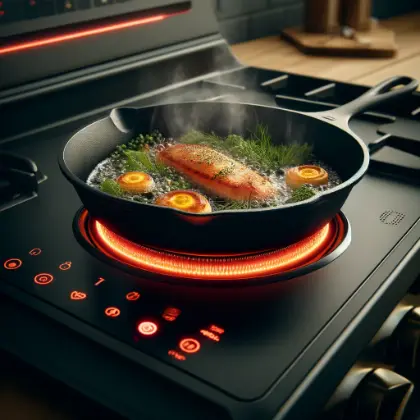
Pros:
- Keeps heat for a long time, making it ideal for slow cooking and frying.
- It can go from stove to oven with ease.
Cons:
- Can be weighty to handle, especially on smooth-top stoves where it can scratch the surface.
- Requires seasoning to prevent rust.
Nonstick Cookware for Electric Stoves
Nonstick cookware is great for easy cooking and cleaning. It is coated with a material that prevents food from sticking.

Pros:
- Food slides off easily, making cleaning a breeze.
- Requires less oil or butter.
Cons:
- Nonstick coatings can be damaged by high heat, so it’s best used in medium or low heat settings.
Using Copper Pots on Electric Stoves
Copper cookware is known for its excellent heat conductivity. However, it is usually lined with stainless steel to prevent reactions with food.
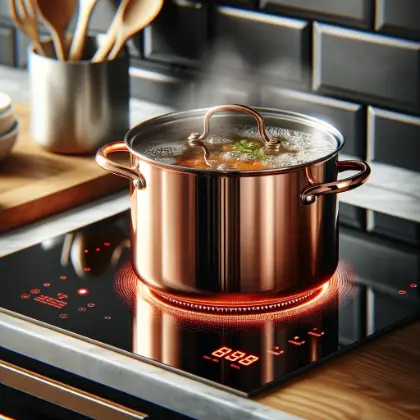
Pros:
- Heats up and cools down quickly, allowing for precise temperature control.
- Provides uniform heat distribution.
Cons:
- Requires regular polishing to maintain its appearance.
- Typically more expensive than other materials.
Aluminum Cookware on Electric Stoves
Aluminum cookware is lightweight and heats up quickly. Anodized aluminum is even better as it is more durable and resistant to scratches.
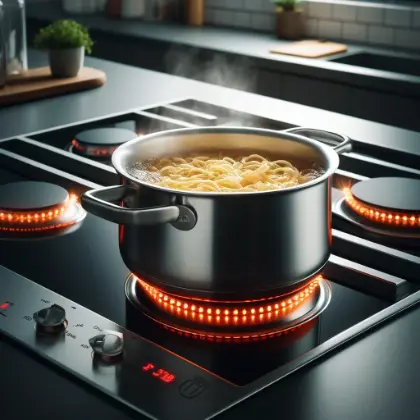
Pros:
- Excellent heat conductivity for fast cooking.
- Easy to handle.
Cons:
- Can react with acidic foods, so anodized aluminum is a better choice.
Glass Cookware for Electric Stoves
Glass cookware is versatile and can go from stove to oven to table. However, it has specific considerations when used on electric stoves.
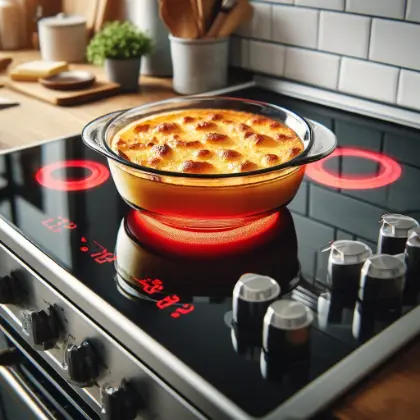
Pros:
- Safe to use with all types of foods.
- Can be used for baking and serving as well.
Cons:
- Heats slowly and unevenly, which can lead to hot spots.
- Prone to breaking if not handled carefully.
Types of Electric Stoves and Cookware Compatibility
Coil Electric Stoves
How They Work:
Coil electric stoves generate heat through exposed electric coils. When the electric current flows through the coils, they heat up, transferring heat directly to the cookware placed on top.
Cookware Compatibility:
- Coil stoves are compatible with a wide range of cookware materials, including stainless steel, cast iron, aluminum, and copper.
- For even heat distribution, it’s essential to use flat-bottomed cookware. This ensures the cookware sits evenly on the coils, maximizing heat transfer.
Smooth-Top Electric Stoves
How They Work:
Smooth-top electric stoves use a radiant heating element beneath a smooth glass or ceramic surface. The heating element warms up, transferring heat through the smooth surface to the cookware.
Cookware Compatibility:
- Smooth-top stoves work best with flat-bottomed cookware. This allows for efficient heat transfer and prevents the cookware from wobbling.
- It’s important to avoid using heavy cast iron or glass cookware that can scratch or crack the smooth surface. Lightweight cookware with a smooth, flat base is recommended for these stoves.
Induction Stoves
How They Work:
Induction stoves use electromagnetic fields to directly heat the cookware. Instead of heating the stove surface, the induction cooktop generates a magnetic field that induces an electric current in the cookware, heating it up directly.
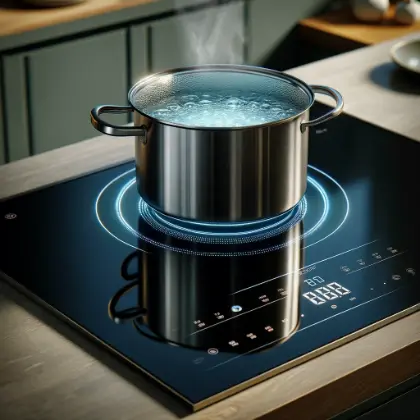
Cookware Requirements:
- Cookware must have a magnetic base to work with induction stoves. Materials like cast iron and some stainless steel are induction-compatible, while aluminum, copper, and glass are not unless they have a magnetic layer on the bottom.
- Just like with standard electric stoves, using cookware with a flat and smooth bottom ensures efficient heating and reduces the risk of damage to the stove surface.
How to Choose the Right Cookware for Electric Stoves?
When selecting cookware for electric stoves, there are several factors to consider to ensure optimal performance and longevity of both the cookware and the stove.
Factors to Consider
Flat Bottom:
The most crucial factor is ensuring the cookware has a flat bottom. A flat bottom ensures even heat distribution, which is essential for consistent cooking results. Warped or uneven bottoms can lead to hotspots and uneven cooking.
Material:
The material of the cookware significantly impacts its performance on an electric stove. Heavy-gauge metals like stainless steel, aluminum, and copper are excellent choices due to their superior heat conduction. We have already given the details about the cookware material.
Size:
Matching the size of the cookware to the burner is another important consideration. Using a pot or pan that is too small or too large for the burner can result in inefficient cooking and heat loss.
Weight:
While heavy cookware can provide good heat retention and even cooking, it should not be so heavy that it becomes difficult to handle. Heavy pots and pans, such as those made from cast iron, can be excellent but ensure they have smooth bottoms to avoid scratching the stovetop.
Durability:
Durable cookware that can withstand high temperatures and frequent use is essential. Materials like stainless steel and cast iron are known for their durability.
Heat Compatibility:
Ensure the cookware can handle the high temperatures typically used in cooking on electric stoves. Some materials, like certain plastics or lower-quality non-stick coatings, may not withstand high heat and can warp or degrade.
Induction Compatibility:
For induction stoves, cookware must have a ferromagnetic base. This means the bottom of the pan must be made of or contain iron. Common induction-compatible materials include cast iron, magnetic stainless steel, and cookware with a magnetic layer.
Glass-Top Considerations:
Glass-top stoves require extra care to avoid scratching or damaging the surface. Use cookware with smooth, flat bottoms, and avoid dragging pots and pans across the surface.
Electric Stove Cookware Recommendations
Here are detailed recommendations for the best cookware:
What Pots and Pans Work Best on Electric Stoves
Choosing high-quality cookware from reputable brands ensures durability and excellent performance. Here are some top brands and materials to consider:
- Stainless Steel: All-Clad, Cuisinart, Calphalon
- Cast Iron: Lodge, Le Creuset, Staub
- Nonstick: T-fal, Calphalon, Rachael Ray
- Copper: Mauviel, T-fal, Cuisinart
- Aluminum: Calphalon, T-fal, Farberware
- Glass: Pyrex, Visions
Practical Tips for Cooking on Electric Stoves
Electric Stove Cooking Tips
Tips for Even Cooking and Heat Distribution
- Preheat the Cookware: Allow the pan to heat up before adding food to ensure even cooking.
- Use Appropriate Burner Sizes: Match the size of the cookware to the burner to maximize efficiency and ensure even heating.
- Stir Food Regularly: Stirring food helps distribute heat evenly, preventing hot spots.
- Use Quality Cookware: Invest in high-quality cookware that conducts heat well, such as stainless steel or copper-bottomed pans.
How to Prevent Scratching the Stove Surface
- Use Flat-Bottomed Cookware: Ensure all pots and pans have flat bottoms to provide even contact with the stove surface.
- Avoid Sliding Cookware: Lift cookware instead of sliding it to prevent scratches.
- Use Protective Mats or Pads: Consider using silicone mats or stove protectors under cookware.
- Choose the Right Cookware Material: Opt for cookware made from materials that are less likely to scratch, such as stainless steel or heavy-duty aluminum.
Conclusion
Choosing the right cookware for your electric stove is crucial for optimal cooking performance and stove longevity. Consider factors like material, bottom shape, and thickness to ensure compatibility and prevent damage. Proper maintenance and cleaning can extend the life of your cookware and stove.
For more information on specific cookware materials or electric stove models, consult manufacturer guidelines or trusted kitchenware resources.
FAQs
1. Can I use grill pans on an electric stove?
Yes, as long as the grill pan has a flat bottom and fits the burner size properly. Grill pans can add versatility to your electric stove cooking.
2. Can I use ceramic cookware on an electric stove?
Yes, but like glass, ceramic heats slowly and may not be as efficient. It’s best for low to medium heat cooking
3. Is it safe to use enamel-coated cookware on an electric stove?
Yes, enamel-coated cookware can be used, but ensure the coating is in good condition to avoid damage. It combines durability with non-stick properties.
4. Can I use induction cookware on an electric stove?
Yes, as long as it has a flat bottom and is made of a suitable material. Induction cookware usually works well with electric stoves.
5. Are non-stick pans safe for electric stoves?
Yes, as long as they have a flat bottom and are of high quality to avoid degradation at high temperatures. Ensure they are free from scratches for best results.
6. What is the best way to clean cookware used on an electric stove?
Follow the manufacturer’s instructions; generally, avoid abrasive cleaners to maintain the cookware’s surface. Mild dish soap and a soft sponge are usually sufficient.
7. What happens if I use warped cookware on an electric stove?
Warped cookware will not make proper contact with the heating element, leading to uneven cooking. This can result in poorly cooked meals.
Please Write Your Comments